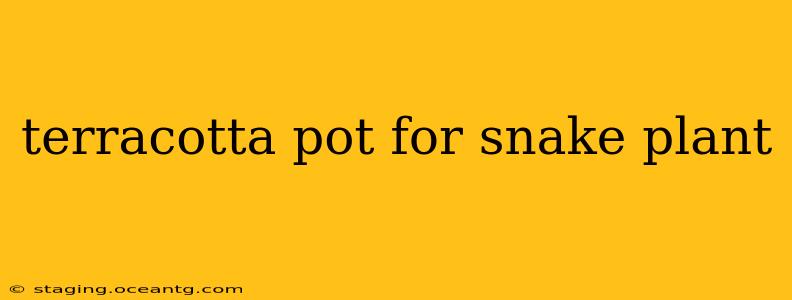Snake plants, known for their resilience and air-purifying qualities, are a popular choice for both novice and experienced plant parents. But what about the pot? While many containers work, terracotta pots have become a favorite for these hardy succulents. This article delves into why terracotta is a popular choice and addresses some common questions surrounding this pairing.
Why Choose a Terracotta Pot for a Snake Plant?
Terracotta pots, made from baked clay, offer several advantages that make them a great choice for snake plants:
-
Porosity: This is the key benefit. Terracotta's porous nature allows for excellent airflow and drainage. This is crucial for snake plants, which are susceptible to root rot if their soil remains overly saturated. The porous nature helps prevent overwatering, a common problem for these low-maintenance plants.
-
Evaporation: The porosity also contributes to faster evaporation of excess moisture from the soil. This regulates the soil's moisture levels, reducing the risk of root rot and ensuring the plant's health.
-
Breathability: The porous nature allows the roots to breathe, promoting healthy root development and overall plant growth. This contrasts with plastic or glazed ceramic pots, which can retain too much moisture and limit airflow.
-
Aesthetic Appeal: Terracotta pots offer a rustic, earthy aesthetic that complements the sleek, modern lines of many snake plants. They come in various shapes, sizes, and finishes, making them versatile additions to any home décor.
What Size Terracotta Pot Should I Use for My Snake Plant?
Choosing the right size pot is essential for your snake plant's health. Generally, you should select a pot that's only slightly larger than the plant's root ball. A pot that's too large can lead to overwatering issues, while one that's too small can restrict root growth. Consider the mature size of your snake plant; you might need to repot it into a larger terracotta pot as it grows.
Does the Material of the Terracotta Pot Matter?
While most terracotta pots are suitable for snake plants, the quality of the clay can influence the pot's porosity and durability. Look for well-made pots that are sturdy and don't have any cracks or imperfections. A higher-quality pot will likely last longer and offer better drainage.
How Often Should I Water My Snake Plant in a Terracotta Pot?
Watering frequency depends on several factors including the pot's size, the surrounding environment, and the time of year. However, because terracotta pots allow for faster evaporation, you'll likely need to water your snake plant less frequently than if it were in a plastic pot. Always check the soil moisture before watering; only water when the top inch or two of soil is dry.
Will a Terracotta Pot Affect the Temperature of My Snake Plant?
Terracotta pots can be slightly more susceptible to temperature fluctuations than other materials. In extremely cold conditions, the pot might cool down quicker, but this shouldn’t drastically affect a hardy snake plant. Similarly, during hot summer months, the pot may absorb heat, so it's important to keep an eye on the soil moisture level to prevent it from drying out too quickly.
Are There Any Disadvantages to Using a Terracotta Pot for a Snake Plant?
While terracotta pots offer many advantages, there are some minor drawbacks:
-
Fragility: Terracotta pots can be more fragile than plastic or ceramic pots. They are more prone to chipping or cracking, especially if dropped.
-
Weight: Terracotta pots can be quite heavy, especially when filled with soil. This can make them more difficult to move or transport.
-
Porosity (can be a double-edged sword): While porosity aids drainage, it can also lead to more frequent watering in dry climates. The pot itself will absorb some of the water as well.
Despite these minor drawbacks, the overall benefits of using a terracotta pot for your snake plant usually outweigh the disadvantages. The improved drainage and aeration are crucial for preventing root rot and promoting healthy growth, making them a top choice for many plant enthusiasts.
